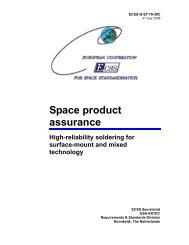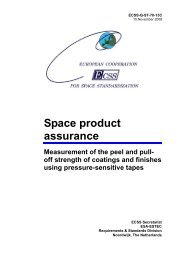ECSS-Q-ST-70-46C
ECSS-Q-ST-70-46C
ECSS-Q-ST-70-46C
You also want an ePaper? Increase the reach of your titles
YUMPU automatically turns print PDFs into web optimized ePapers that Google loves.
4.1.4 Heat treatment<br />
<strong>ECSS</strong>‐Q‐<strong>ST</strong>‐<strong>70</strong>‐<strong>46C</strong><br />
31 July 2008<br />
a. Headed forged blanks shall be heat treated and cold worked by rolling or<br />
drawing methods in conformance with the customer specification<br />
document for threaded fasteners and the specifications in clause 4.2 of<br />
this Standard.<br />
b. Forged blanks belonging to the same batch shall be heat treated in one<br />
batch.<br />
c. The supplier shall re‐treat a batch which, tested as in 4.3.3, did not meet<br />
the mechanical property requirements, no more than twice (three times<br />
for Titanium alloys).<br />
d. If a different supplier produces the blanks, inspections and quality<br />
control shall be performed as specified in 4.4.2.1 under direct<br />
responsibility of the original blanks’ supplier.<br />
NOTE This is done in the case where the supplier is<br />
unable to carry out the blank fabrication as<br />
requested by the customer.<br />
e. Grinding of shank and head bearing surfaces of blanks to obtain<br />
roughness values as specified in 4.2.4 shall be carried out after any heat<br />
treatment.<br />
4.1.5 Head-to-shank fillet rolling<br />
a. Head‐to‐shank fillet rolling shall be carried out after any heat treatment<br />
and machining processes.<br />
b. Cold rolling shall remove from the fillet surface any evidence of previous<br />
machining or etching process.<br />
c. Geometrical distortion of the fillet surface shall be within the limits<br />
specified in 4.2.3.<br />
NOTE In fasteners having compound radii between head<br />
and shank, cold rolling can be extended to the<br />
remaining part of the fillet surface.<br />
d. There shall be no machining or etching of the fillet radius after rolling.<br />
4.1.6 Threads<br />
a. External threads shall be formed by rolling process.<br />
b. Thread rolling shall be carried out on each fastener in one single<br />
continuous operation.<br />
c. When thread rolling on each fastener is not performed in one single<br />
continuous operation, the threaded fasteners shall be submitted to a<br />
fatigue test in conformance with 4.3.5.<br />
d. When threads are machined oversized and subsequently rolled, no<br />
evidence of machining shall be observed on the thread surface after<br />
rolling.<br />
NOTE This applies for fasteners of large diameter.<br />
e. Thread rolling shall be carried out after heat treatment and machining of<br />
fasteners.<br />
12
















